#Warren G. Harding
Text

#Did You Know?#facts#trivia#U.S. history#U.S. presidents#Warren G. Harding#Warren Harding#squirrels#ice cream#ice-cream cone#you can’t make this stuff up
112 notes
·
View notes
Text
Warren G. Harding

Physique: Average Build
Height: 6’ (1.83 m)
Warren Gamaliel Harding (November 2, 1865 – August 2, 1923) was the 29th president of the United States, serving from 1921 until his death in 1923. A member of the Republican Party, he was one of the most popular sitting U.S. presidents. After his death, a number of scandals were exposed, including Teapot Dome, as well as an extramarital affair with Nan Britton, which tarnished his reputation where he is generally regarded as one of the worst presidents. Harding died of a heart attack in San Francisco while on a western tour and was succeeded by Vice President Calvin Coolidge.

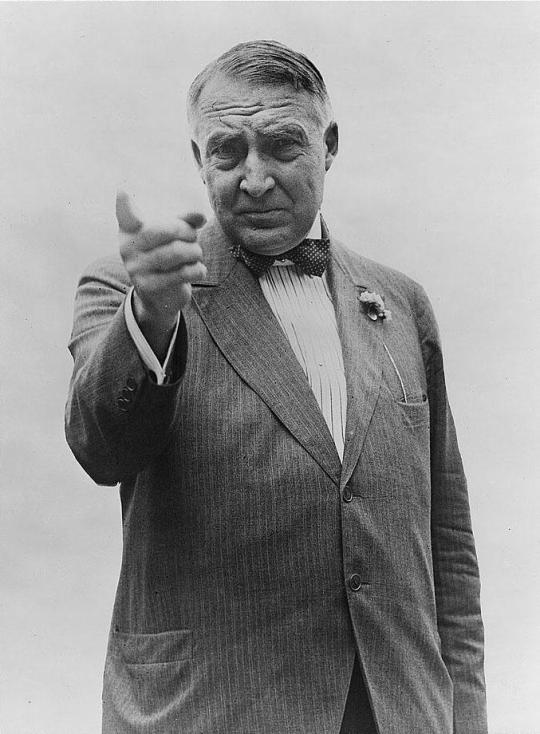

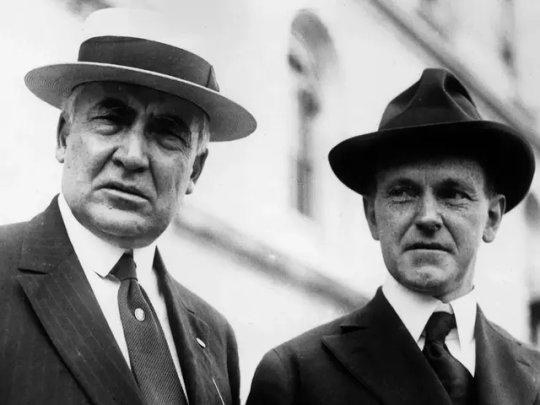
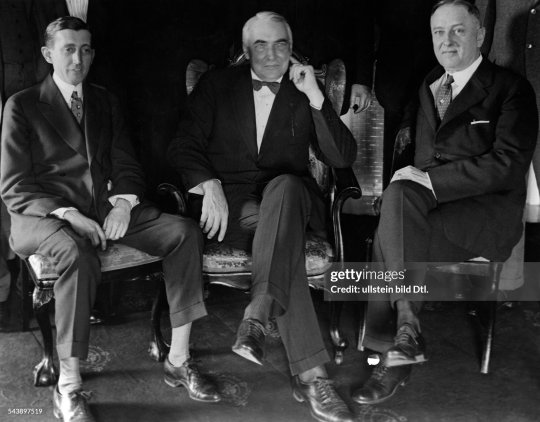
Handsome with a grumpy look who was always well dressed and well groomed, many historians have argued people only voted for him because he “looked presidential”. I think he did and he definitely look fuckable.




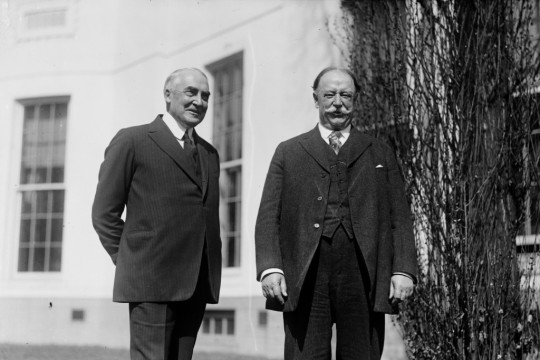
Harding married Florence Kling De Wolfe, a divorcee with one son. The Hardings had no children together. Harding reportedly had affairs with Carrie Phillips (his wife’s best friend) and Nan Britton (She lost her virginity to him when she was twenty and Harding was fifty) who bare a child during the 1910s and early 1920s, prior to his death in 1923. He wrote tawdry letters to all his lovers filled with euphemism and sexual innuendoes (“Jerry” was the code word for his penis.) And he had so many female admirers (nicknamed his lollapaloozas) that his security guards worked overtime, keeping them at bay.


What else do I know about other than he being a whore. He often play poker with his Cabinet, nicknamed the “Ohio gang”, used tobacco in all its forms - cigarettes, cigars, snuff, a pipe and chewing tobacco, serve bootleg whiskey to his guests and would also sneak off in the middle of the night to watch burlesque shows. Now I wish I could get him drunk, play poker with him and put my ass on the line. Or something to that effect.

32 notes
·
View notes
Text

President Warren G. Harding shakes hands with a rather anxious-looking Babe Ruth during a visit to Yankee Stadium, where the ballclub was playing the Washington Senators, April 4, 1923.
Photo: Bettmann Archive/Fine Art America
#vintage New York#1920s#Babe Ruth#Warren G. Harding#NY Yankees#April 4#4 April#U.S. president#Yankee Stadium#baseball#vintage baseball
113 notes
·
View notes
Text
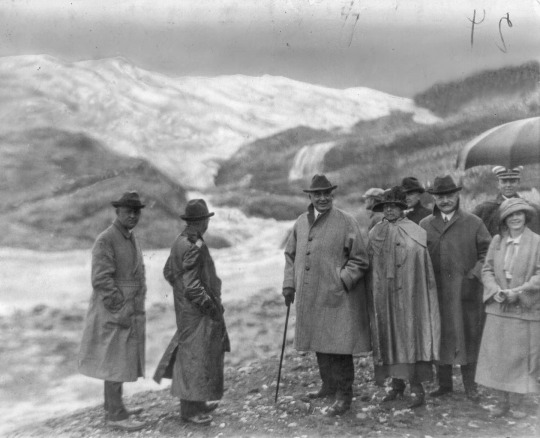
Exactly 100 years ago, President Warren Gamaliel Harding escaped the sweltering summer weather and increasingly dark political climate of Washington, D.C. to embark upon a lengthy cross-country trip through parts of the American West still relatively unaccustomed to frequent visits by the nation’s Chief Executive. Billed as a “Voyage of Understanding”, Harding’s trip was seen as a prelude to his potential campaign for re-election the following year, and an opportunity to put some literal and figurative distance between the President and the rumors of rampant corruption swirling around some of Harding’s friends and closest aides from Ohio, as well as several Cabinet members — rumors eventually proven to be true, resulting in indictments, convictions, prison sentences, and even suicides. As President Harding prepared for his Western tour, he could feel the heat as the scandals plaguing his Administration began to reach a boiling point. Speaking privately to the famous journalist and editor William Allen White, Harding said of the Presidency, “My God, this is a hell of a job! I have no trouble with my enemies…But my damn friends, they’re the ones that keep me walking the floor nights.”
Harding’s planned 15,000-mile Voyage of Understanding began on June 20, 1923. Traveling aboard the private Pullman railroad car Superb, the 57-year-old President left Washington, D.C. accompanied by First Lady Florence Harding, Speaker of the House of Representatives Frederick H. Gillett, new Interior Secretary Hubert Work, and a large retinue of aides, friends and their families, doctors, Secret Service agents, and members of the press. Work had become Secretary of the Interior a few months earlier when the previous Secretary, Albert B. Fall, became the “fall guy” for the Teapot Dome scandal. For his role in the scandal, Fall was later convicted of accepting bribes — the first former Cabinet member in American history to serve time in prison for crimes committed while in office. At later points along the journey, Harding’s party was also joined by Secretary of Agriculture Henry C. Wallace (father of future Vice President Henry A. Wallace) and Secretary of Commerce (and future President) Herbert Hoover.

The last week of June 1923 was spent traveling through the Mountain West — Colorado, Wyoming, Utah, Idaho, Montana, and Yellowstone National Park. The beginning of July saw the Presidential party in the Northwest and celebrating Independence Day in Portland, Oregon before boarding the USS Henderson in Tacoma, Washington on July 5, 1923 to sail to Alaska. One of the expected highlights of the Voyage of Understanding was the northernmost leg of the trip, as Harding became the first incumbent President of the United States to visit Alaska and Canada. The Territory of Alaska had been purchased for the United States by Secretary of State William Seward in 1867 when Warren G. Harding was two years old, and at the time of Harding’s visit, Alaska was still 35 years from being admitted to the Union as the 49th state. But the President spent nearly the entire month of July traveling through the state, mixing public appearances with private recreation and sightseeing. On July 15, 1923, Harding hammered a golden spike in Nenana, Alaska to officially complete the Alaska Railroad. And ten days later, the President crossed into Canada, fishing on the Campbell River in British Columbia on July 25th and then making an official visit the following day in Vancouver, where he was greeted by one of the largest crowds of his voyage — estimated at over 40,000 people — and where he also squeezed in a round of golf at the exclusive Shaughnessy Golf Club.

The President returned to American soil on July 27th, arriving in Seattle and making several speeches in a busy six-hour period — first to Camp Fire Girls at Volunteer Park, then to nearly 30,000 Boy Scouts at Woodland Park, and finishing the day addressing over 30,000 people at what is now Husky Stadium at the University of Washington where he predicted statehood for Alaska, where he had spent most of the month. After making a brief appearance that evening at the Seattle Press Club, Harding boarded his train that night to travel to Portland, Oregon.
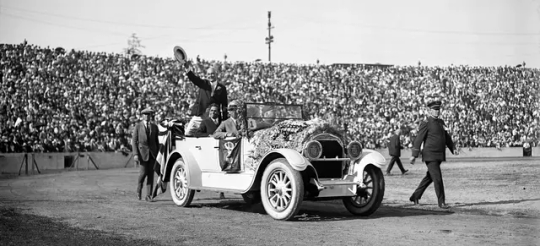
But something was not right. The President seemed to be exhausted, perhaps from the grueling trip through geography much wilder than Harding’s native Ohio or swampy Washington, D.C. Despite his exciting journey through Alaska and the energetic welcome provided by the Canadian people, Harding was clearly wiped out by the time he reached British Columbia. The President did head to the country club while in Vancouver, but he was so tired that after six holes of golf his foursome skipped directly to the eighteenth hole, seemingly completing the round without tipping off the press that Harding couldn’t play the entire course.
From the White House, nine days before embarking upon his Voyage of Understanding, Harding wrote a quick note to Solicitor General James M. Beck who had wished the President a safe journey on his upcoming trip. Thanking Beck, Harding wrote, “I shall try to remember not to overdo (it) in crossing the continent.” And, on June 14, 1923, six days before leaving, President Harding wrote a short letter to a young girl from Hartford, Connecticut named Vivian Little, who had recently sent the President a four-leaf clover as a good luck charm. “Thank you so much for the four-leaf clover which you were so good as to press and send to me,” the President wrote. “I hope it will bring me good luck and that it will bring you still more of the same.”
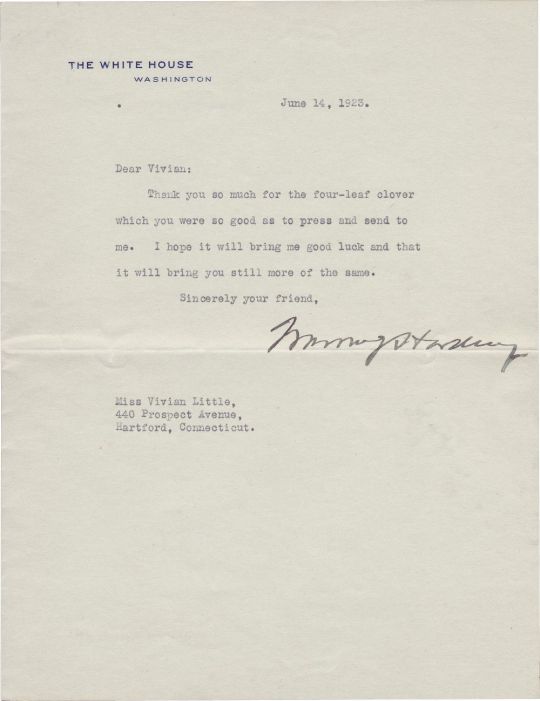
However, any luck that President Warren G. Harding still had seemed to be running out. Ill and exhausted after leaving Vancouver, Harding tried to rest aboard the USS Henderson as it sailed to Seattle in the early morning hours of July 27. At some point around 3 AM, Harding and the other passengers aboard the Henderson were jolted awake as the ship crashed into the USS Zeilin, an American destroyer accompanying the Presidential party while they traveled through the foggy Puget Sound. This was not the first mishap of the Voyage of Understanding. While traveling through Colorado early in the trip, three people from the President’s party had been killed in a car accident. And now, after a few weeks in Alaska where Harding was able to at least temporarily forget about his Administration’s many troubles, the President was not only sick and tired but two of his Navy’s ships had just smashed into each other almost as soon as he had returned to the continental United States. While the USS Zeilin was badly damaged in the collision, the USS Henderson was not and there were apparently no major injuries on either vessel. But when the President’s valet, Major Arthur Brooks, came to Harding’s stateroom aboard the Henderson to inform him that the captain was calling for all hands on deck, he found the depressed President lying on his bed with his face buried in his hands. “I hope the boat sinks,” President Harding quietly muttered.
It was just hours later that Harding made his whirlwind tour through Seattle, putting on a brave face at his public appearances, but clearly not feeling well. While he was never considered a brilliant orator like Abraham Lincoln, Benjamin Harrison, or his immediate predecessor, Woodrow Wilson, Harding was a strong speaker and excellent communicator who had a unique ability to connect with audiences, but he was obviously — and unusually — halting and confused while speaking in Seattle on July 27th. As he boarded his train at Seattle’s King Street Station that night, Harding was examined by his doctor and by Interior Secretary Hubert Work, who had once been a physician, and they decided to cancel the next several days of planned activities. Instead of stopping in Portland and then visiting Yosemite National Park, the Presidential party was ordered to proceed directly to San Francisco where Harding could rest before giving a speech on the radio planned for July 31st which was expected to be heard by over 5 million people.
Despite the four-leaf clover that had been sent to him by Vivian Little before his Voyage of Understanding, Warren Gamaliel Harding’s luck seemed to be running out. And, as his train sped through Oregon en route to San Francisco’s Palace Hotel on July 28, 1923, President Harding was also running out of time.
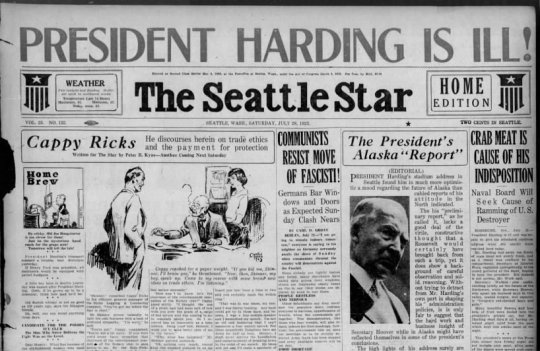
#History#Presidents#Warren G. Harding#President Harding#Death of Warren G. Harding#100 Years Ago#100th Anniversary#Centennial#Presidential History#Voyage of Understanding#Politics#Political History#Harding Administration#Presidential Deaths#Teapot Dome#Presidential Scandals#Presidential Corruption#Political Scandals#Political Corruption
45 notes
·
View notes
Text
Presidential Man Slut Poll Round 1
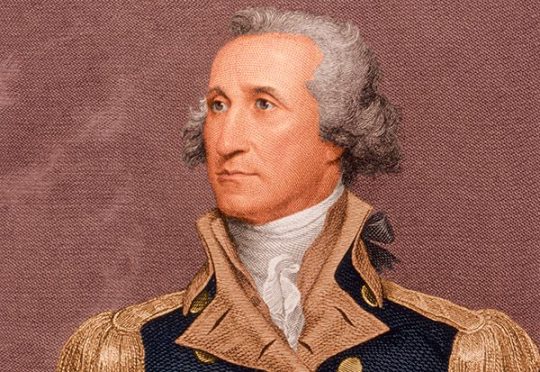
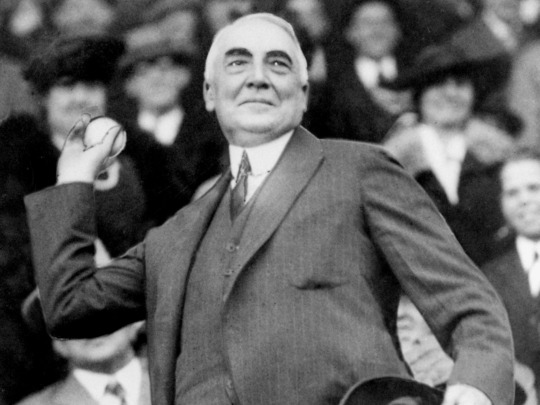
Vote for who you think has the absolute sluttiest vibes! Learn more at the FAQ. This poll ends on Saturday, 25 February 2023.
Remember to reblog to make sure everyone gets a chance to vote. That’s democracy, babey!!!!
22 notes
·
View notes
Photo

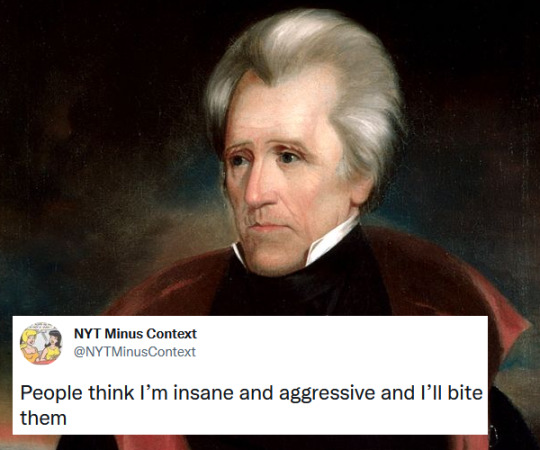

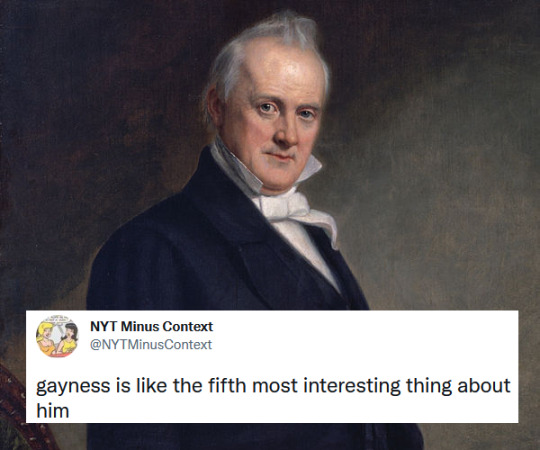


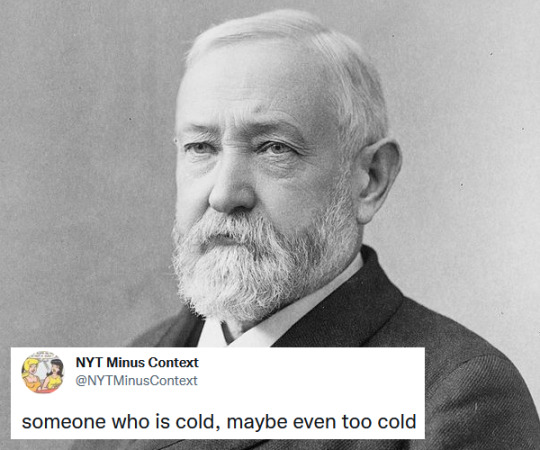


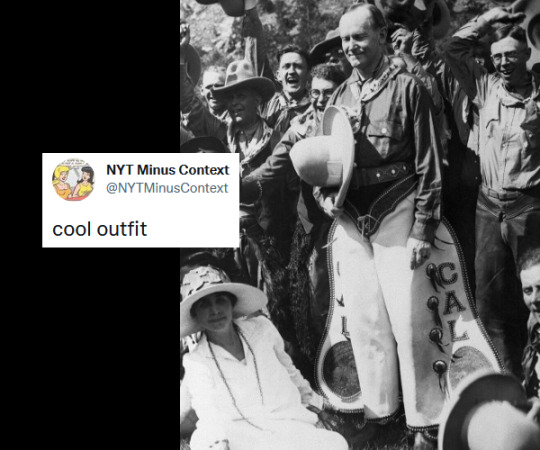
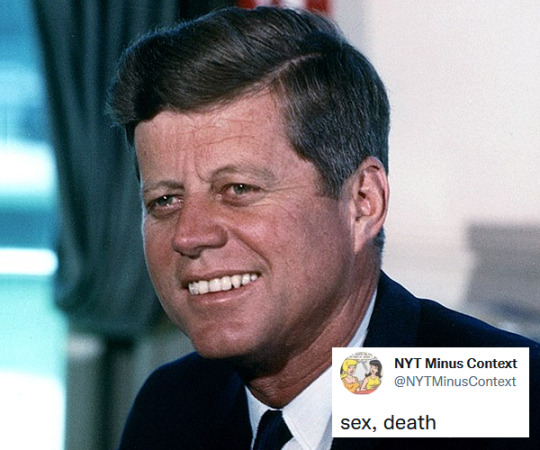
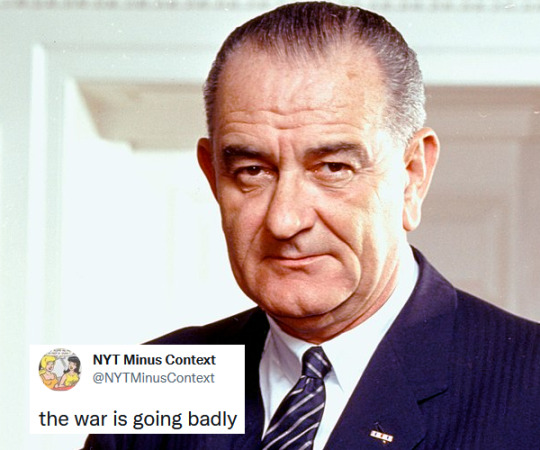
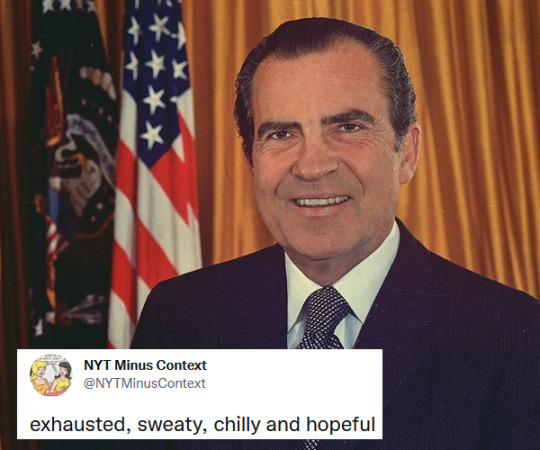
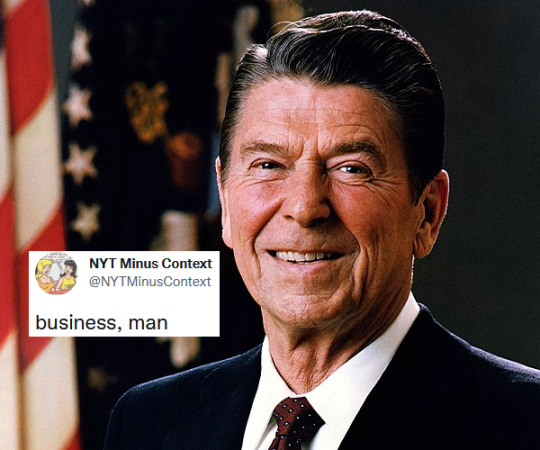




US presidents + NYT minus Context
#nyt minus context#george washington#andrew jackson#franklin pierce#james buchanan#abraham lincoln#andrew johnson#benjamin harrison#william howard taft#warren g. harding#calvin coolidge#john f. kennedy#lyndon b. johnson#richard nixon#ronald reagan#george w. bush#barack obama#donald trump#joe biden
81 notes
·
View notes
Text
Princeton University Presidential Straw Poll, October 21, 1920
Harding: 877
Cox: 464
Debs: 9
Watkins: 9
Christiansen: 5
(Source)
#On This Day#1920s#presidential election#poll#Princeton#Warren G. Harding#James M. Cox#PrincetonU#Princeton University
2 notes
·
View notes
Text
Reblog this if you want
#chester a. arthur#grover cleveland#benjamin harrison#william mckinley#theodore roosevelt#william howard taft#woodrow wilson#warren g. harding#calvin coolidge#us presidents#asking questions
6 notes
·
View notes
Photo

“Commander-in-Clown”
It was difficult picking which president to use.
The choice was between Harding, Coolidge, and FDR.
-Jimmy Purcell.
#beenbettercomic#been better comic#beenbetter#been better#beenbetterclowncharity#webcomics#webcomic#quite a leap#clown#felix adler#warren g. harding#president#history#jen#comics#comicstrip#comic strip
2 notes
·
View notes
Text

April 24, 1922
Mutt and Jeff by Bud Fisher: "Yes, the Little Fellow is Very Versatile"
[ID: Mutt stands on the sidewalk, chatting with Spivis. /end]
Mutt: Spivis, where's Jeff keeping himself?
Jeff: Haven't you heard? He's opened up a studio in the fine arts building and gone in for sculpturing!
[ID: Mutt struts down the street with purpose. /end]
Mutt: Jeff must be crazy! He has more illusions than any man I know of!
[ID: He climbs a staircase, following a sign that reads, "Jeff's Studio - Third Floor!" /end]
Mutt: He'll starve at that work! He won't get a customer in a hundred years!
[ID: Mutt peeks in the door and is shocked beyond belief to discover the identity of Jeff's sitter - Warren G. Harding sits on a chair while Jeff sculpts his bust. /end]
Mutt: The President!!!
Warren G. Harding: And Jeff, did you ever heard the one about the three Irishmen?
Jeff: No, Warren! Shoot! I know it must be good!
#newspaper comics#vintage#history#1922#mutt and jeff#transcript available#1920s#warren g. harding#and his repertoire of racist jokes#sculpture
2 notes
·
View notes
Text

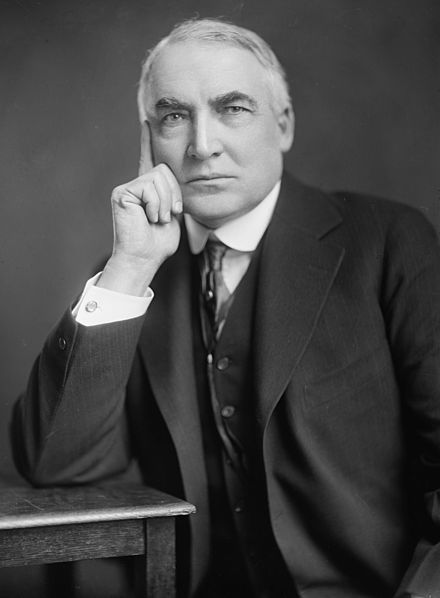
On This Day: The first telephone was installed in the white house under Rutherford B. Hayes, but it wasn't used for phone sex until Warren G. Harding
0 notes
Text

ITS SO OVER
1 note
·
View note
Text
Contextualizing Trump
There are lots of different ways to approach the indictment of former President Trump on thirty-seven felony counts, but presuming the man’s guilt in advance should not be one of them: like anyone at all charged with a crime in our nation, the ex-President enjoys the presumption of innocence until such time as he is actually convicted of a crime. With that, none (I hope) can argue. Nor should anyone question his right to defend himself vigorously in court and to be aided in that defense by able counsel: all these are basic rights accorded to all accused individuals without exception and really should not be questioned at all, let alone challenged. The man has no more rights than anyone, but also no fewer!
But the larger question facing the American people as we wait to see what happens next is how to contextualize the whole affair. Surely, the principle that none is above the law is basic to any democracy. I lost track early on of how many times I heard those words cited in this specific context in the last week, which is as it should be: the notion that the sign of a truly healthy democracy is precisely that neither wealth nor status can protect someone from facing the legal consequences of his or her actions in a court of law is really unarguable. But that’s not quite the tack I wish to take in analyzing this last week’s events, which is to wonder aloud how to set last week’s indictment in its larger context. Of interest too is that President Trump’s former valet (now his aide), Walt Nauta, was also named in the indictment as a co-conspirator. That surprised me, but whether he is destined to turn into Gary from Veep or to morph into this year’s Michael Cohen remains to been. (Both went to jail, but one remained faithful to his boss and the other turned on him.) But the concept itself that the big man’s little man is going to have to answer for his own misdeeds is also a healthy sign that the law applies to the mighty and the lowly alike, just as it should and must.
One way to contextualize the indictment would be to do so horizontally by scanning the globe for similar stories. Of these, there is no lack. In 2021, the former president of France, Nicolas Sarkozy, was sentenced to a year in prison for corruption and influence peddling. The former president of South Africa, Jacob Zuma, has been charged with racketeering and money laundering, and will face trial. Ehud Olmert, the twelfth Prime Minister of Israel, was convicted of taking bribes and obstructing justice, then sentenced to six years in prison. And, of course, the Prime Minister of Israel, Benyamin Netanyahu, is also on trial for bribery and fraud. And that’s only to mention the most recent world leaders to face trial in their own countries. Nor was Israel the only country to put two of its political leaders on trial this century: Sarkozy’s predecessor, Jacques Chirac, was found guilty of paying bribes and accepting kickbacks in 2011 and handed a two-year suspended prison sentence. If this were a contest, though, South Korea would probably win: in the last three decades, five different former South Korean presidents have been tried and convicted of various offences. For a useful and very interesting summary published on the PBS website of world leaders who have been arrested, tried, and convicted (or not convicted), click here.
It's actually a very satisfying list to contemplate, one populated by politically powerful and mostly very wealthy individuals who were specifically not deemed to be above the law and who were therefore obliged to defend themselves in courts of law against the charges brought against them. But I’d like to propose an alternate way of contextualizing the Trump indictment, one rooted in American history rather than in the stories of other nations.
In the course of the last century, four presidents have had their reputations seriously tarnished by charges of criminal wrongdoing leveled against themselves or others close to them. Of them, however, Donald Trump is the first actually to face federal criminal charges. But considering no. 45 in the light specifically of three of his predecessors—nos. 29, 37, and 42—is an interesting exercise nonetheless.
Sometimes, it’s enough merely to be associated with bad people.
Warren Gamaliel Harding, no. 29, was in office for less than two and a half years, wrapping up his service to the nation in the summer of 1923 by suffering what was probably a serious heart attack while visiting Washington State and then dying a few days later in San Francisco. That he seems to have had a series of extra-marital affairs, including one that probably resulted in an illegitimate child and another that memorably featured a White House tryst in a closet off the Oval Office with Secret Service agents posted in the hallway to keep the couple safe from intruders, hasn’t helped his reputation. But it was not his infidelity that damaged his reputation—the nation had learned not to care much about that back in the days of Grover Cleveland—as much as it was his association with people later accused of serious crimes, including his Secretary of the Interior Albert Fell (who was later convicted of accepting hundreds of thousands of dollars in bribes in what came to be called the Teapot Dome Scandal) and his Attorney General, Harry Daugherty, who was tried on charges of corruption but in the end not convicted. Key is to realize that Harding himself was dead when all this came out and that he himself was never accused of actual wrongdoing while still alive and serving as President. And yet his name was so posthumously tarnished that he is regularly rated as among the very worst of our American presidents. So we begin with the story of a man who was tarnished by association, whose willingness to consort with men later openly labelled—in the court of public opinion as well as in actual courtrooms—as criminals ruined his reputation. This we could reasonably call guilt by posthumous association.
Moving along, we could consider the fate of William Jefferson Clinton, no. 42. Bill Clinton was accused over the years by at least four different women of sexual assault, but not by Monica Lewinsky, who never described herself as an assault victim. Nonetheless, it was lying about that specific relationship that led independent prosecutor Kenneth Starr to charge Clinton with perjury and obstruction of justice. This led directly to the December 1998 vote in the House of Representatives to impeach Clinton, which led to his five-week trial in the Senate. (That Kenneth Starr was supposed to be investigating the Clintons’ role in the Whitewater Real Estate scandal and not the president’s sex life may well have contributed to the sense among many that the president was being tried in the Senate unfairly.) Clinton was acquitted, but his reputation was severely tarnished by the whole affair, which would put him in a slightly different category than Warren Harding: both are remembered as philanderers, but Clinton’s famous “I did not have sexual relations with that woman” combined with his impeachment, his trial in the Senate, the suspension of his license to practice law in Arkansas, his disbarment from presenting cases in front of the U.S. Supreme Court, his being held in contempt of civil court, and the $90,000 fine he was obliged to pay for giving misleading testimony in court—all these together ruined Clinton’s reputation in the eyes of many. He is, of course, still alive and well, which puts him in a different category than Warren Harding, who at least had the good fortune to have his reputation ruined posthumously. And he has clearly bounced back to being a respected past-president whose company is sought out and whose counsel if valued.
And that brings me to no. 37, the president of my college years, Richard M. Nixon. In February of 1974, a federal grand jury was prepared to indict the by-then-former president by charging him with a variety of crimes connected with his association with the Watergate break-in: bribery, conspiracy, obstruction of justice, and obstruction of a criminal investigation. What would have happened if they had actually indicted him is hard to say—but it never happened because Congress was busy drawing up the articles of impeachment that led directly to Nixon’s resignation on August 8, 1974. The next day, Gerald Ford took the oath of office and became president. And a month after that, President Ford pardoned his predecessor, thus protecting him from criminal prosecution. (The question of whether Nixon effectively made Ford president in exchange for the promise of a pardon has never been settled. Ford was obliged to deny formally that such a deal existed when he was called to the House Judiciary Committee in the fall of 1974. But deal or no deal, that pardon cost him mightily: his approval rating dropped from 71% to 50% after he pardoned Nixon and that single act probably cost him the 1976 election.) It would be fair to say Nixon’s legacy was permanently tarnished by his decision to resign, which was understood at the time as a kind of unspoken yet somehow fully audible admission of guilt. And his reputation too was left in tatters by the whole sorry affair. So Nixon’s story presents yet a third version of doing what it takes to avoid paying the piper: Harding skipped the whole thing by dying before the corruption in his own cabinet became known, Clinton swallowed one bitter pill after the next but eventually walked away intact from the whole nightmarish series of disasters he basically brought down upon himself, and Nixon accepted the humiliation of resignation and then flew off into the sunset to live out his life in California.
And now, Trump. Could he end up in prison? It feels impossible to imagine that actually happening, and yet the crimes with which he has been charged could easily and would probably lead to incarceration for a non-ex-president who wasn’t actually the front runner for his party’s nomination to run for president next year. Eugene Debs famously ran for president in 1920 from a prison cell. (He lost, slightly amusingly, to the above-mentioned Warren G. Harding.) And, if he had won, Debs would theoretically have not been barred by his own incarceration from serving. (He had promised to pardon himself if elected, however, which action with respect to himself would certainly be on the agenda for the first day of Prisoner Trump’s new term of office.) Still, the basic principle upon which any true democracy rests—the Torah’s own principle of one single set of laws governing all, rich and poor, powerful and powerless, well-connected and poorly connected and totally disconnected—that specific principle is alive and well in our American republic. And regardless of the outcome of the Trump trial in Florida, that is something for all to celebrate.
1 note
·
View note
Text





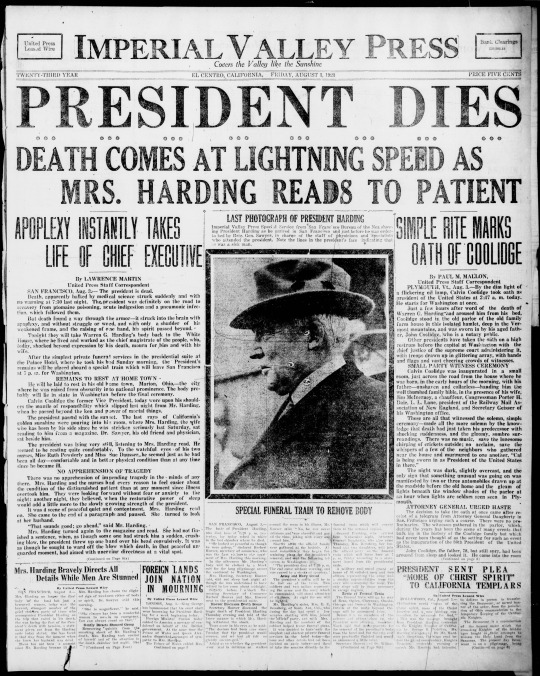
More newspaper front pages announcing the death of President Warren G. Harding and the succession of Calvin Coolidge, August 3, 1923.
#History#Warren G. Harding#Presidents#President Harding#Harding Administration#Death of Warren G. Harding#Harding Death Centennial#100 Years Ago#100 Years#Harding Death#Politics#Political History#Presidential History#Calvin Coolidge#President Coolidge#Inauguration of Calvin Coolidge#Vice President Coolidge#Newspaper Front Pages
25 notes
·
View notes
Text
Then there's Warren G. Harding:
The McKinley book was 483 pages, the Harding book 175. This is partially a measure of the different access to primary sources with each, partially that one is a full-scale biography and the other a short part of an ongoing sequence of Presidential biographies. The main thrust of this one is that based on the primary sources Harding was unfairly blamed and caricatured for Teapot Dome, but at the end of the day the President selects the people under him as a grown-ass man and as such death does not absolve Harding from the consequences of selecting one of the more crooked Administrations before Watergate.
That said the book does note that for all that he spoke of 'normalcy' that Harding did far more for civil liberties than Woodrow Wilson did and at least rhetorically was more radical than anyone in office would be on civil rights until Lyndon Baines Johnston. He did die before having any real opportunities to measure what his words were intended to be.
8/10.
#lightdancer comments on history#lightdancer comments on literature#presidential biographies#warren g. harding#when you can be fairly compared to Nixon you're not in a good way#the book says this is wrong#I disagree#Harding might have been more than a non-entity leading crooks and liars#but he still led the crooks and liars and appointed them
0 notes
Text
youtube
Warren G. Harding continues to find his name at the bottom of the presidential rankings. Ryan Walters, the author of "The Jazz Age President: Defending Warren G. Harding," believes his name should move up the list...way up. The Sons of History discuss why Harding is a much-maligned president, but really shouldn't be. In fact, there is a case to be made that he was one of the more successful presidents of the 20th century.
#Warren G. Harding#Harding#The Jazz Age President#MorHistory#History#Moribund Institute#Ryan Walters#The Sons of History#Youtube
0 notes